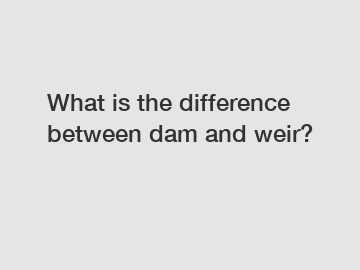What is the difference between dam and weir?
What is the difference between dam and weir?
Dams and weirs are both structures that are commonly used in water management and control. While they may serve similar purposes, there are distinct differences between the two. Understanding these differences is essential in determining the most appropriate structure for a given situation. So, let's delve into the contrasting features of dams and weirs.
1. Purpose:

a. Dams: Dams are primarily constructed to store and regulate water. They are often built on larger rivers or streams to impound water for various purposes, such as irrigation, power generation, and flood control. Dams are usually much bigger and more complex structures compared to weirs.
b. Weirs: On the other hand, weirs are designed to divert or control the flow of water. They are typically constructed across smaller streams or channels and serve purposes like measuring flow rates, preventing erosion, and guiding water to specific areas. Weirs are generally simpler and less massive structures compared to dams.
2. Structure:
a. Dams: Dams are normally constructed using concrete or earth materials. They are built across entire river sections or valleys and often involve massive reservoirs behind them. The structure of a dam is engineered to withstand high water pressure and store large volumes of water. They may include intake towers and outlets to control water flow and release.
b. Weirs: Weirs, on the other hand, have a more open structure compared to dams. They can be constructed using concrete, stone, or even natural materials like timber. Weirs consist of a series of low-level walls or obstructions placed across a river or channel. Some weirs may have gates or adjustable components to regulate water flow. Due to their simpler structure, weirs are typically easier and quicker to construct than dams.
3. Water Control:
a. Dams: Dams excel in water storage, allowing the controlled release of water as required. They have spillways through which excess water can be safely discharged during periods of heavy rainfall or flooding. By regulating the flow of water, dams can help manage water scarcity during dry periods and ensure a stable water supply for various purposes, such as drinking water and agriculture.
b. Weirs: Weirs are primarily focused on controlling water flow and may not possess the large storage capacity of dams. They divert water to a specific direction or collect water in channels for irrigation or other purposes. Weirs can be modified to regulate water levels but are not typically used to store water on a large scale.
4. Environmental Impact:
a. Dams: Constructing dams often involves significant environmental impact. The creation of reservoirs can flood large areas, leading to the displacement of ecosystems, wildlife, and human settlements. Dams may also disrupt fish populations and alter natural river flows. However, they can provide hydroelectric power, mitigate floods, and ensure water availability during droughts.
b. Weirs: Weirs have a relatively lower environmental impact compared to dams. Since they are smaller structures, the ecological consequences are generally minimal. Weirs can sometimes enhance the habitat and biodiversity in the areas where they are constructed, particularly by creating riffles and pools that benefit aquatic species.
In conclusion, while dams and weirs are both water management structures, they have distinct differences in their purpose, structure, water control capabilities, and environmental impact. Dams are built for large-scale water storage, power generation, and flood control, while weirs are primarily used to control water flow and divert it to specific areas. Understanding these variations is crucial in determining which structure is most suitable for a particular situation, taking into consideration factors such as the size of the waterbody, water management objectives, and ecological impact.
Are you interested in learning more about Containerized Water Treatment Plant, Containerized Seawater Desalination Plant, Irrigation Inflatable Rubber Dam? Contact us today to secure an expert consultation!
123
0
0


Comments
All Comments (0)